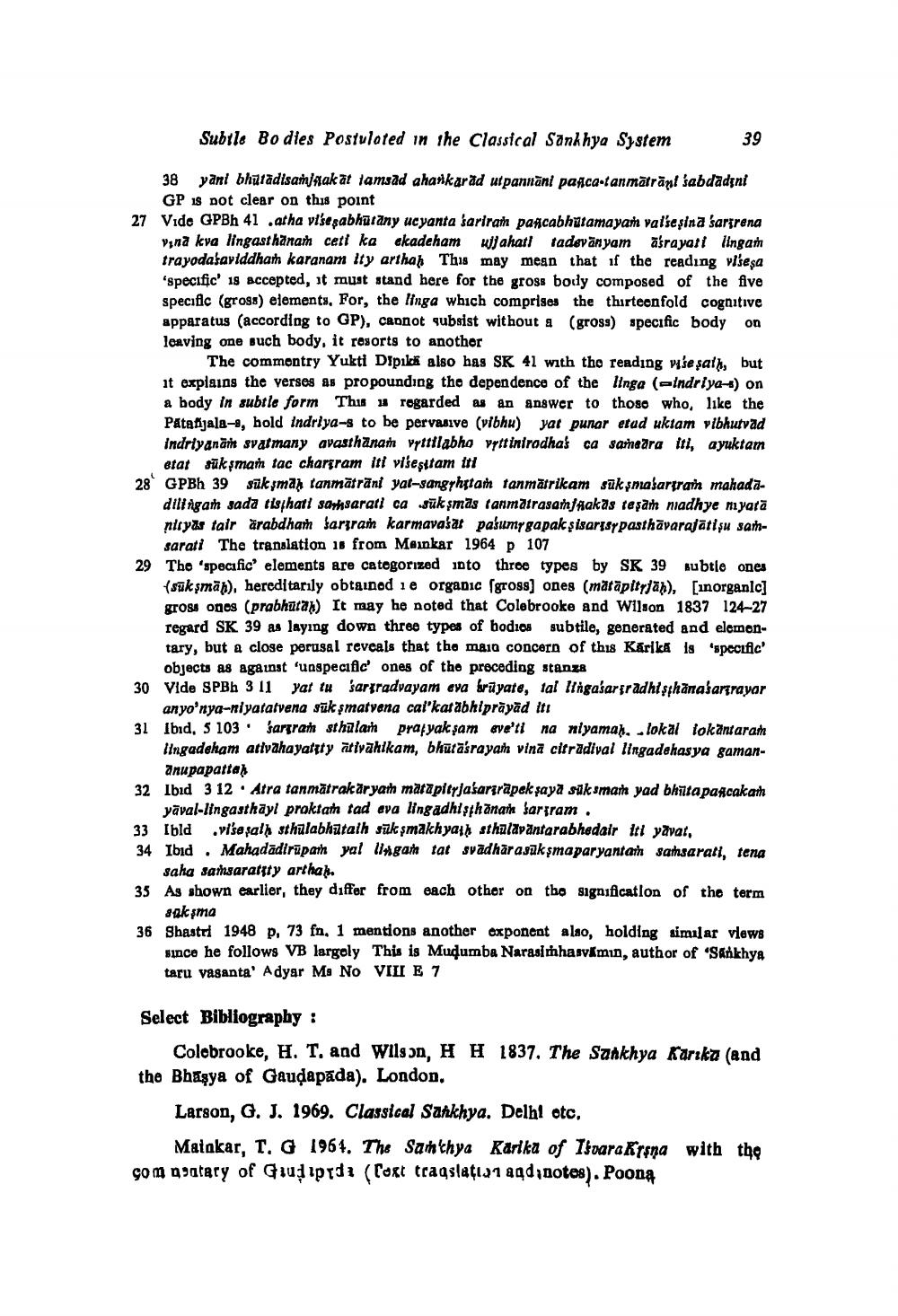________________
Subtle Bodies Postuloted in the Classical Sankhya System
39
27
oped, at mult, arthan the nighati radeon
38 yani bhūtādisamaak āt lamsad ahaskarad utpannāni pafca-tanmätränt sabdadeni GP is not clear on this point Vide GPBh 41 .atha visesabhutany ucyanta sariram pancabhutamayam val'seşina sartrena Vgna kva lingasthanamh ceti ka ekadeham wjjahati tadsvänyam ābrayari lingam trayodasaviddhan karanam Ity arthah This may mean that if the reading wisesa 'specific' 18 accepted, it must stand here for the gross body composed of the five speciflc (gross) elements, For, the linga which comprises the thirteenfold cognitive apparatus (according to GP), cannot gubsist without a gross) specific body on leaving one such body, it rosorts to another
The commentry Yukti Dipikk also has SK 41 with the reading weşath, but It explains the verses as propounding the dependence of the linga (Indriya-4) on a body in subtle form Thu u rogarded as an answer to those who, like the Patafjala-2, hold Indriya-s to be pervasive (vibhu) yat punar etod uktam vibhutvad indriyanām svatmany avasthanam vyttilabho Yrttintrodhas ca santara iti, ayuktam
etat sük sma tac chargram iti višesttamiti 28 GPBh 39 sūksmah tanmätrant yal-sangyhitam tanmätrikam sūksmatartram mahada
dilingan sada tishati samsarati ca sūksmas tanmatrasanfaakās teşan niadhye nyara ntryos tair ärabdham Sargram karmavasat pakumy gapak sisarisy pasthāvarafātisu sam
sarati The translation is from Mainkar 1964 p 107 29 The 'specific elements are categorized into throe types by SK 39 subtle ones
(suk smaß), hereditarily obtainod 1e organic (gros) ones (märāpitrjāņ), (inorganlc] gross ones (prabhūray) It may he noted that Colebrooke and Wilson 1837 124-27 regard SK 39 as laying down three types of bodios subtile, generated and elemontary, but a close perusal reveals that the main concern of this Karika is 'specific
objects as against 'unspecific ones of the preceding stanza 30 Vide SPBL 3 11 yat tu sargradvayam eva brūyate, tal lliga arsradhisthanasartrayar
anyo'nya-niyatatvena sūk smatvena cal'katabhiprāyād its 31 Ibid, 5 103. sargram sthalam prafyak sam sve'ti na niyamaḥ, lokal fokäntaram
lngadeham ativahayatīty ativahlkam, bhūtāśrayath vina citradival lingadehasya gaman
anu papattas 32 Ibid 312 · Atra tanmätrakaryamh marzpityjasararapek saya sük smam yad bhūtapancakah
yāval-lingasthāyl proktan tad eva lingadhisthanath Sarfram. 33 Iuld visesal) sthalabhatalh sūk smakhyath sthulavantarabhedair iti yavat, 34 Ibid. Mahadādirūpam yallingah tat svādhārasūksmaparyantah sahsarall, tena
saha samsaratty arthak. 35 As shown earlier, they differ from each other on tho signification of the term
saksma 36 Shastri 1948 p, 73 fn, 1 mentions another exponent alao, holding similar Views
since he follows VB largely This is Mudumba Narasimha vimin, author of 'Sankhya taru vaganta' Adyar Me No VIII E 7
Select Bibliography :
Colebrooke, H. T. and Wilson, HH 1837. The Sankhya Karika (and the Bhagya of Gaudapāda). London.
Larson, G. J. 1969. Classical Sankhya. Delhl etc.
Malakar, T. G 1964. The Santhya Karika of Iboara Krena with the com agatary of Giuliprdi (Coxt tragslati31 94d.notes). Poona




